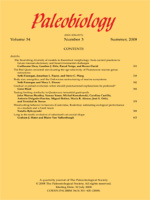Temporal asymmetries in clade histories have often been studied in lower Paleozoic radiations. Post-Paleozoic patterns, however, are less well understood. In this paper, disparity and diversity changes in Mesozoic heart urchins were analyzed at the ordinal level, with contrasts among the sister groups Holasteroida and Spatangoida, their paraphyletic stem group Disasteroida, and the more inclusive clade, the superorder Atelostomata. A 38-dimensional landmark-based morphospace representing test architecture was used to describe morphological evolution in terms of total variance and total range. Discordances between disparity and diversity were evident and were expressed both as deceleration in morphological diversification in all groups and as disproportionately higher disparity early in the histories of the Atelostomata, Holasteroida, and Spatangoida. The finding that the early atelostomate disparity peak coincides with the origin of the orders Holasteroida and Spatangoida lends support to the perception of orders as semi-independent entities in the biological hierarchy and as meaningful proxies for morphological distinctness.
A comparison of holasteroid and spatangoid responses to the end-Cretaceous mass extinction revealed morphological selectivity. Paleocene spatangoid survivors showed no change in disparity relative to the Campanian-Maastrichtian sample, suggesting nonselectivity. Holasteroids suffered a pronounced loss in disparity (despite a rather high Late Cretaceous level of disparity), indicating morphological selectivity of extinction.
Partitioning of disparity into plastral and nonplastral components, reflecting different degrees of developmental entrenchment and functionality, suggests that the origin of holasteroids and spatangoids is more consistent with an exploration of the developmental flexibility of nonplastral constructions than with uniform ecospace occupation. Within groups, several patterns were also most consistent with intrinsic controls. For plastral landmarks, there is an apparent increase in developmental modularity and decrease in developmental constraint from disasteroids to holasteroids and spatangoids. For nonplastral landmarks, no substantial change in disparity was observed from disasteroids to holasteroids and spatangoids, suggesting the maintenance of a developmental constraint despite the passage of time and ecological differentiation. More generally, this study suggests that certain topologies of disparity and evolutionary mechanisms potentially characteristic of the lower Paleozoic radiations of higher taxa (e.g., developmental flexibility) need not be confined to any given time period or hierarchical level.





